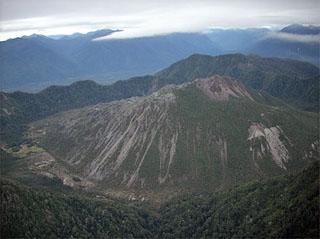Report on Chaiten (Chile) — 14 October-20 October 2009
Smithsonian Institution / US Geological Survey
Weekly Volcanic Activity Report, 14 October-20 October 2009
Managing Editor: Sally Sennert.
Please cite this report as:
Global Volcanism Program, 2009. Report on Chaiten (Chile) (Sennert, S, ed.). Weekly Volcanic Activity Report, 14 October-20 October 2009. Smithsonian Institution and US Geological Survey.
Chaiten
Chile
42.8349°S, 72.6514°W; summit elev. 1122 m
All times are local (unless otherwise noted)
Based on web camera views and analyses of satellite imagery, the Buenos Aires VAAC reported that on 14 October an ash plume from Chaitén's lava-dome complex rose to an altitude of 2.1 km (7,000 ft) a.s.l. and drifted 150 km NNE. A diffuse plume was seen the next day drifting 15 km SW at the same altitude as the previous day. During 15-16 October, a thermal anomaly was seen. On 18 October, a possible plume drifted 50 km SE at an altitude of 2.1 km (7,000 ft) a.s.l. Diffuse ash plumes possibly mixed with steam and gas rose to an altitude of 1.8 km (6,000 ft) a.s.l. on 20 October and drifted NE and SE.
Geological Summary. Chaitén is a small caldera (~3 km in diameter) located 10 km NE of the town of Chaitén on the Gulf of Corcovado. Multiple explosive eruptions throughout the Holocene have been identified. A rhyolitic obsidian lava dome occupies much of the caldera floor. Obsidian cobbles from this dome found in the Blanco River are the source of artifacts from archaeological sites along the Pacific coast as far as 400 km from the volcano to the N and S. The caldera is breached on the SW side by a river that drains to the bay of Chaitén. The first recorded eruption, beginning in 2008, produced major rhyolitic explosive activity and building a new dome and tephra cone on the older rhyolite dome.

